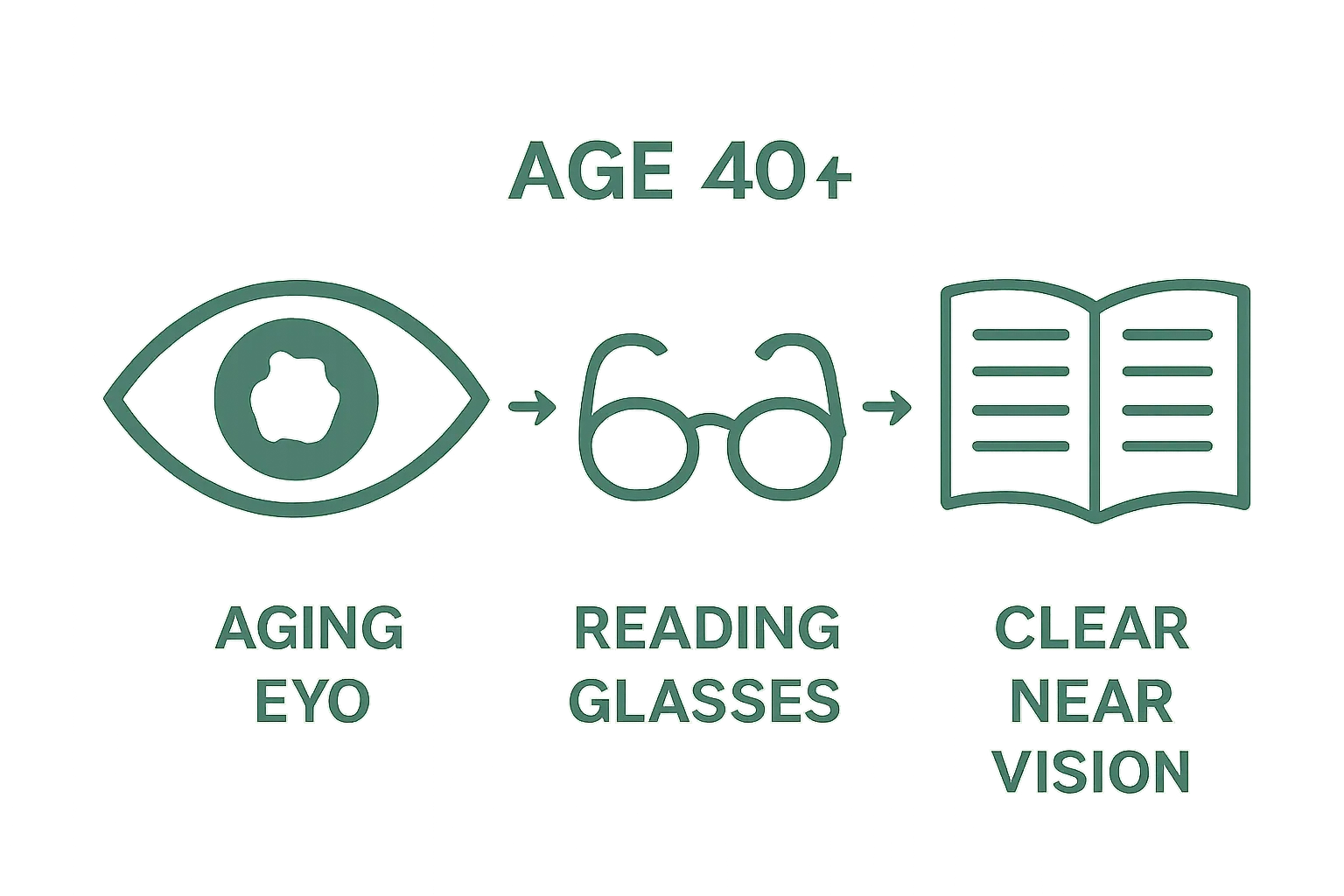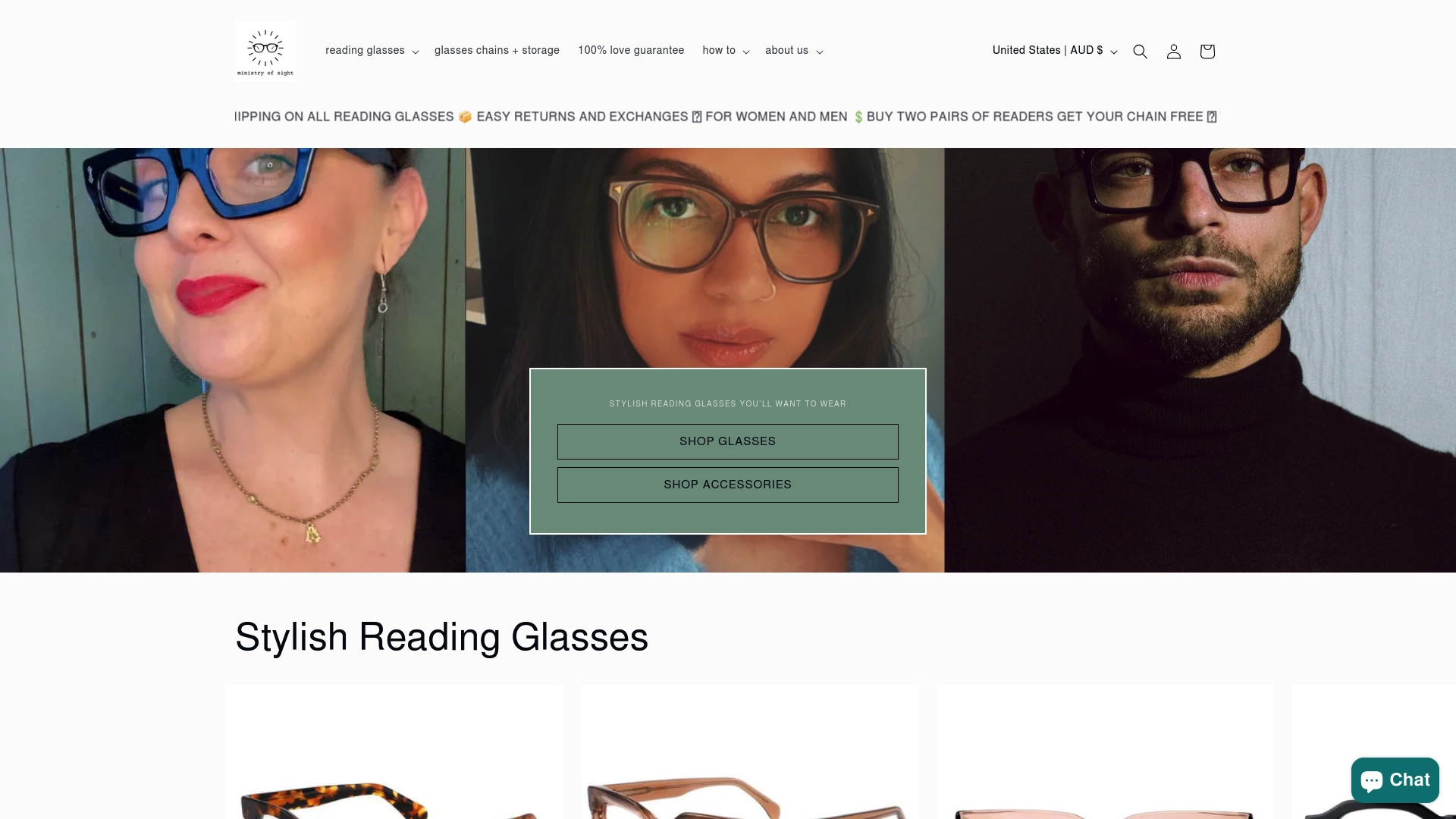
Understanding What are Reading Glasses and Their Importance
Reading the fine print on a medication label or a favourite novel gets tougher as the years fly by. Most Aussies don’t realise that presbyopia hits nearly everyone over 40 and suddenly everyday close-up tasks become a hassle. What surprises plenty of people is that the solution is actually simpler and more effective than most expect. Reading glasses bring clear vision back within reach and the reasons why might just make you rethink how you look after your eyes as you age.
Table of Contents
- What Are Reading Glasses And Their Purpose
- Why Do We Need Reading Glasses As We Age?
- How Reading Glasses Improve Vision For Near Tasks
- Key Features Of Reading Glasses Explained
- Choosing The Right Reading Glasses For Your Needs
Quick Summary
| Takeaway | Explanation |
|---|---|
| Reading glasses assist near vision | They enhance clarity for reading, detailed work, and close-up tasks. |
| Presbyopia affects focus after 40 | Aging leads to less lens flexibility, making it hard to see close objects. |
| Choose the right magnification strength | Lens strength ranges from +1.00 to +3.00 diopters for personalized support. |
| Consider comfort and fit when selecting | Frame design and materials impact the wearer’s comfort during use. |
| Regular eye exams help determine needs | Professional assessments identify individual vision requirements for optimal clarity. |
What are Reading Glasses and Their Purpose
Reading glasses represent a specialised visual aid designed to assist people experiencing challenges with near vision, particularly as they age. These optical devices provide targeted magnification that helps individuals read, write, work on detailed tasks, and engage in close-up activities with enhanced clarity and comfort.
The Fundamental Purpose of Reading Glasses
Reading glasses solve a common vision problem called presbyopia, a natural age-related condition where the eye’s lens becomes less flexible. This biological change makes focusing on nearby objects progressively more difficult, typically emerging around age 40-45. Reading glasses compensate for this reduced focusing ability by providing additional lens power that allows the eyes to see text and close objects more clearly.
Key characteristics of reading glasses include:
- Designed specifically for near-vision tasks
- Available in standardised magnification strengths
- Lightweight and easy to use
- Typically worn only during reading or close-up work
How Reading Glasses Function
The mechanism behind reading glasses is straightforward yet ingenious. When you put on reading glasses, the lens provides extra magnification that helps your eyes focus more easily on text or objects within a close range. These lenses essentially act as an external focusing mechanism, supplementing your eye’s reduced natural ability to adjust.
For most people, reading glasses become an essential tool that helps maintain independence and quality of life. Learn more about how reading glasses support adult vision and discover the subtle ways these simple devices can dramatically improve daily experiences.
Whether you are reading a novel, checking medication labels, threading a needle, or working on intricate craft projects, reading glasses offer a practical solution to maintain visual clarity and reduce eye strain during close-up activities.
Why Do We Need Reading Glasses as We Age?
Aging brings numerous changes to our bodies, and our eyes are no exception. As individuals progress through their 40s and 50s, natural physiological transformations occur within the visual system that gradually impact near vision capabilities, making reading glasses an increasingly essential visual aid.
Understanding Age-Related Vision Changes
The human eye contains a remarkable lens that naturally adjusts its shape to focus on objects at different distances. This lens becomes less flexible with age, a process called presbyopia. During younger years, the eye’s lens can easily contract and expand, allowing seamless focus between near and distant objects. However, around age 40, the lens begins losing its elasticity, making close-up tasks increasingly challenging.
Key vision changes associated with aging include:
- Reduced lens flexibility
- Decreased muscle strength in eye focusing mechanisms
- Slower visual processing speeds
- Increased difficulty reading small print
Biological Mechanics of Vision Decline
The biological mechanism behind vision changes is rooted in microscopic transformations within the eye. Protein structures within the lens become less malleable, making it harder for the eye to change focus quickly. This natural aging process means that reading small text, threading needles, or examining detailed work becomes progressively more difficult.
Explore why reading glasses might be necessary even at a younger age and understand the early signs of vision adaptation.
Reading glasses provide a practical solution by offering external magnification that compensates for the eye’s reduced focusing ability. They essentially act as a supplementary lens, helping individuals maintain visual clarity and continue performing detailed tasks with confidence and ease.

How Reading Glasses Improve Vision for Near Tasks
Reading glasses serve as a critical visual tool that transforms how individuals interact with close-up tasks, providing precise magnification that enables clearer, more comfortable near vision. These specialised optical devices restore visual clarity by compensating for natural age-related focusing limitations.
Magnification and Visual Clarity
The primary function of reading glasses is to enhance visual acuity for near-distance activities. By adding supplementary magnification, these glasses help the eye focus more effectively on detailed tasks such as reading text, working on intricate crafts, or examining small objects. The lenses essentially act as an external focusing mechanism, allowing the wearer to see fine details with improved precision and reduced eye strain.
Key benefits of reading glasses include:
- Immediate visual clarity for close-up tasks
- Reduced eye fatigue during detailed work
- Improved ability to read small print
- Enhanced performance in precision activities
Functional Mechanisms of Visual Enhancement
Reading glasses work by strategically bending light rays before they reach the eye, creating a magnified image that compensates for the reduced focusing ability of aging eyes. Different magnification strengths address varying levels of vision requirements, ensuring personalised visual support. Discover the different types of reading glasses that can improve your vision and find the perfect match for your specific needs.
These optical aids are particularly crucial for maintaining independence and quality of life, enabling individuals to continue enjoying reading, crafting, and other detailed activities without frustration or visual limitations. By providing an external solution to natural biological changes, reading glasses represent a simple yet powerful tool for visual enhancement.

Key Features of Reading Glasses Explained
Reading glasses are more than simple visual accessories. They represent a sophisticated optical solution designed to address age-related vision challenges with precision and functionality. Understanding their key features helps individuals make informed choices about their visual support.
Essential Structural Components
The design of reading glasses encompasses several critical elements that contribute to their effectiveness. Frame construction plays a pivotal role in comfort and usability, with variations ranging from lightweight plastic to durable metal materials. Different frame styles accommodate diverse facial structures and personal aesthetic preferences.
Below is a table detailing the main structural components and features of reading glasses to help you understand what elements to consider when selecting a pair.
| Feature/Component | Description |
|---|---|
| Lens Material | Usually polycarbonate or optical glass for clarity and durability |
| Frame Design | Options include full frame, half frame, and rimless styles |
| Nose Pad Configurations | Variations for comfort and fit |
| Temple Arm Flexibility and Length | Determines comfort and suitability for different face shapes |
| Magnification Strength | Ranges from +1.00 to +3.00 diopters for personalised support |
| Lens Coating Options | Includes anti-reflective, blue light filtering, scratch-resistant |
| Weight and Material | Lightweight (plastic, metal) for prolonged comfortable wear |
Key structural components include:
- Lens material (typically polycarbonate or optical glass)
- Frame design (full frame, half frame, rimless)
- Nose pad configurations
- Temple arm flexibility and length
- Lens coating options
Magnification and Lens Characteristics
Magnification represents the core functional aspect of reading glasses. Strength levels typically range from +1.00 to +3.00 diopters, allowing users to select precisely matched visual correction. The lens power directly correlates with the degree of near-vision assistance required, ensuring personalised visual support.
Check out our comprehensive reading glasses selection guide to determine the most suitable magnification for your needs.
Additionally, modern reading glasses incorporate advanced features like anti-reflective coatings, blue light filtering, and scratch-resistant treatments. These technological enhancements extend beyond basic magnification, providing comprehensive visual comfort and protection during close-up tasks.
Choosing the Right Reading Glasses for Your Needs
Selecting the perfect reading glasses involves more than simply grabbing a pair off the shelf. It requires careful consideration of personal vision requirements, lifestyle factors, and individual comfort preferences. Understanding your specific visual needs is the foundation of finding reading glasses that truly enhance your daily experience.
Assessing Personal Vision Requirements
Determining the appropriate reading glasses begins with a comprehensive understanding of your near vision challenges. Age, existing vision conditions, and the types of tasks you typically perform will influence your ideal lens strength and design. A professional eye examination provides the most accurate baseline, helping you identify the precise magnification needed for optimal visual clarity.
Key considerations when selecting reading glasses include:
- Current age and vision changes
- Typical close-up tasks and activities
- Existing vision prescriptions
- Comfort and fit preferences
- Frequency of near-vision work
Matching Glasses to Lifestyle and Comfort
Frame selection goes beyond aesthetic appeal, encompassing functional aspects that impact daily wearability. Lightweight materials, flexible temple arms, and appropriate nose pad designs contribute significantly to overall comfort. Learn more about choosing the right lens types for your reading glasses to ensure a perfect match for your visual needs.
Consider factors like workplace environment, hobbies, and personal style when selecting reading glasses. Whether you require glasses for extended reading, computer work, or intricate crafting, the right pair can dramatically improve your visual experience and reduce eye strain.
Experience Clearer Close-Up Vision with Stylish Reading Glasses
Struggling with blurry print, tired eyes, or frustration when doing close-up tasks is a common challenge that comes with presbyopia, as explored in this article. Many people want to maintain independence and enjoy their hobbies, but reduced lens flexibility and increasing eye strain can make everyday reading or detailed work difficult. Choosing the right reading glasses tailored for your vision needs can restore clarity and boost your confidence during all your near-vision activities. Discover our Square Reading Glasses collection, combining comfort, durability, and a range of magnifications to help you read with ease and style.

Do not let fading near vision hold you back from what you love. Take action now and browse our latest range of high-quality reading glasses for men and women, or add convenience with Reading Glasses Accessories and Storage to keep your favourites safe. The clarity, comfort, and confidence you need for daily life is just one choice away.
Frequently Asked Questions
What are reading glasses designed for?
Reading glasses are specifically designed to assist individuals with near-vision tasks. They provide targeted magnification, helping users see clearly when reading, writing, or engaging in detailed activities.
Why do people need reading glasses as they age?
As people age, they often experience presbyopia, a condition that reduces the eye’s ability to focus on nearby objects. Reading glasses compensate for this loss of flexibility in the eye’s lens, making close-up tasks easier to perform.
How do reading glasses improve vision for near tasks?
Reading glasses enhance visual clarity by providing extra magnification for close-up activities. They help the eye focus more effectively, reducing eye strain and allowing for improved visibility of small text and fine details.
What should I consider when choosing reading glasses?
When selecting reading glasses, consider your personal vision requirements, typical close-up tasks, existing vision conditions, and comfort preferences. A professional eye examination can help determine the correct magnification needed for optimal clarity.
Recommended
- Understanding the Role of Reading Glasses for Adults – ministry of sight
- Understanding the Complete Reading Glasses Checklist – ministry of sight
- Understanding the Types of Reading Glasses for Better Vision – ministry of sight
- Understanding the Reading Glasses Fit Guide for Better Vision – ministry of sight


















